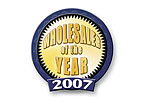
This year’s Wholesaler of the Year is a much larger company than it was the first time Standard Plumbing Supply was so honored by this magazine way back in 1975. Then, SUPPLY HOUSE TIMES founder Charlie Horton wrote about a company headquartered in Salt Lake City and with seven branches situated in Utah, Idaho and Oregon. Standard now has some 70 branches situated in those three states and since extended into Arizona, California, Colorado, Nevada and Wyoming.
In 1975, our Wholesaler of the Year was a $12 million company with some 106 employees. Those figures included a pipe manufacturing business that has since been sold. The company’s distribution operation alone now has a little more than three times that amount of staff right now, yet more than 10 times the volume.
Our 1975 coverage contained scant mention of the company’s then modest showroom operations. Now Standard operates 50 showrooms, including an eye-popping 14,000-sq.-ft. extravaganza at its headquarters complex in Sandy, an adjacent suburb of Salt Lake City. (See sidebar story, “Standard’s Category-Killer Showrooms”.)
Opened in 2001, company headquarters now occupies a 16-acre site that includes more than 300,000 sq. ft. spanning nine buildings. It’s conveniently located just a few blocks from entry to I-15, the key interstate highway passing through Salt Lake City.
In 1975, the man in charge was Dale Reese, who founded the company in 1952 and passed away last year. Son Richard Reese has served as president ever since the early ’90s and has proven every bit as entrepreneurial as his father.
Back then, plumbing was pretty much the name of their game. Standard has since expanded significantly into HVAC and hydronic heating. Some locations have separate plumbing and HVAC stores housed in adjacent buildings.
These changes over three decades-plus are a function of growth - averaging a spectacular 27% per year from the time Richard took over from his father in 1992 through 2006. However, that growth has been anchored to a business model whose elemental chemistry isn’t much different than the one we detailed in 1975. Now, as then, the company’s M.O. includes:
Underlying it all is a culture of self-sufficiency in which Standard personnel try to do everything possible internally to cut costs and assure quality control.
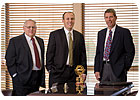
Entrepreneurial Spirit
President Richard Reese presides as CEO over a tightly managed company with two key second-tier executives. Dave Freeman, vice president of showrooms and strategic initiatives, is a plumbing distribution veteran who had worked for Hajoca and Stapley Wholesale before joining the company a decade ago. Freeman oversees all plumbing and hydronic heating operations.Blair Tucker, vice president of the HVAC Division, was recruited 11 years ago to boost the company’s presence in that market sector. Starting with a few aisles in selected branch stores, he has since built that business into a dozen stand-alone stores. Tucker’s HVAC department is capable of supplying and assisting contractors in every phase from system design to product selection, spanning both residential and commercial.
Reese is the conceptualizer, Freeman and Tucker the nuts-and-bolts implementers. People I’ve spoken with both inside and outside the company pay tribute to Reese as an extremely perceptive businessman and visionary. “I’ve been in this business a long time, and have never seen anyone with Richard’s ability to see new opportunities,” said Freeman. “He’s not bogged down looking at the way we did things in the old days.”
The trio is assisted by various capable aides, and a team of branch managers that Reese identifies as the real key to their success. “The most important thing we can do is hire the right manager. It doesn’t matter how good our distribution system is, or our support systems and showrooms. If that local branch manager doesn’t have entrepreneurial spirit, we can’t compete,” he stated.
The company doesn’t have a formal recruitment and training program, just a knack for recognizing and nurturing talent. Although they have hired some from the outside with varying degrees of success, most of Standard’s branch managers were developed from within. Several of them - Gaylen Schetselaar (South Salt Lake), Eric Wahlstrom (Sandy), Sterling Hill (Orem) and Josh Kunkel (West Jordan) - started out as truck drivers or warehouse workers and ended up running million-dollar branches within a couple of years.
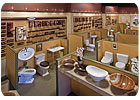
Centralization Leads To Freedom
Standard’s management philosophy is to take charge of the administrative drudgery so as to free the people in its branches to focus on sales and running their local operations. The formula has worked phenomenally for over half a century.A key component is advanced computer technology that has been a company signature ever since the early days of computerization in the industry. Our 1975 Wholesaler of the Year coverage took note of Standard’s use of Burroughs mini-computers in managing its operations. That was pretty much state-of-the-art distribution technology for its time, and gives off a whiff of nostalgia to those of us who can recall a time when PCs had not yet come into the picture.
Standard’s IT today is anchored in an Infor distribution management system customized so that Standard’s business methodology drives computer operations rather than the other way around. They outsource computer programming, though they employ a single IT person full-time to troubleshoot and keep things humming.
There is no facet of company administration and operations that isn’t automated to the nth degree. Of special note is their advanced purchasing and inventory control capabilities, known as Stock Support.
Branch managers can order anything they need by adding it to their transfer request from Stock Support, but nearly all needs are handled automatically by the system in response to Economic Order Quantity (EOQ) and Order Point Line Point formulas. Same with billing, credit and other humdrum but critical details of the distribution business. As a result, most Standard branches operate with miniscule staffs ranging from two to five people.

Self-Service Pioneer
Another reason they can get by with skeleton staffing is Standard’s self-service operations. Standard Plumbing Supply was a pioneer of self-service in the plumbing supply distribution industry, as was described extensively in our 1975 coverage. They have had three more decades to perfect these operations.Standard’s self-service spans all products, not just the fast-moving and impulse items. Customers have unobstructed access to the entire store to pick out their own tubs, toilets, water heaters, etc. Pipe yards have plenty of space for contractors to pull their trucks up for easy loading.
Although there are about 20,000 SKUs in the stock file at each branch available through Stock Support, no branch stocks that many. The average is about 10,000. Warehouse space is given over mostly to self-service shelving and product displays. So the facilities resemble retail stores more than supply houses. There is some variation in products on display in light of local market preferences, but they follow standard layouts and shelf arrangements. Taking a cue from the big box retailers, shelf stock is arranged in logical progression from rough to finish products, with impulse items prominently displayed in front.
The company markets its own private label line of products called “Plumber Friendly.” This is a competitive line that gets displayed in its own area between the showroom and in front of the self-service shelves. Their private label serves the economy niche market, while showrooms are geared to more upscale offerings.
Reese regards his company’s self-service as a competitive edge. “It enables contractors to get their stuff quickly and be gone. They recognize that their time is more valuable than the parts they are buying.
“Many contractors that used to have a shop and take weekly deliveries no longer have a shop,” he added. “They find it more economical to drive to Standard Plumbing in the morning, pick up what they need, do the job and then come back to get materials for the next job. In small towns it’s feasible to do that.”

Locations, Locations, Locations
With exceptions such as Salt Lake City and Idaho’s capital city, Boise, Standard’s Intermountain West market mostly consists of a bunch of small towns. Except for two minor acquisitions, Standard has built its extensive branch network almost entirely from the ground up over the years. “You pay either way,” said Reese. “If we open our own location, there’s a capital investment of so much per month. But if we buy someone else’s business, we have to start with a big fat check up front. Even as fast as we’ve grown, we’ve never had a huge amount of money to finance big purchases.” At one time a few years ago they had a dozen building construction projects going at the same time, although at last report they were down to two.They like to open in small towns where they’re the only supply house, at least until someone follows their lead. Local customers tend to reward the company with the bulk of their business because, thanks to Standard’s central distribution system, customers can get virtually anything they need within a day, and most often at a better price than from someone outside the market.
Dave Freeman is charged with determining which towns are big enough to support a branch. He used to do a lot of demographic research but learned a simple shortcut. “I just look at where there’s a Wal-Mart. They’ve already done the market research, and that’s worked out pretty well for us,” said Freeman. Not only do they look for suitable towns, but prime locations within those towns that will draw showroom traffic and provide easy access to major highways. In keeping with its culture of self-sufficiency, they prefer to own rather than lease facilities. If no suitable property is available to purchase, they’ll build anew.
Standard’s facilities are built to cookie-cutter specs, resulting in buildings that are functional without being drab. The company color used to be white with red lettering, but Standard has changed to red upon earth tone coloration in recent years, although a few branches have yet to be repainted. Neatness is instilled in the managers. The half-dozen branches I visited were some of the tidiest I’ve seen in a 30-year career of visiting supply houses.
Customers invariably enter the plumbing branches through the showroom. In back of the showroom is the pickup counter leading to a spacious self-service area. The shelves are separated by wide aisles that allow for ease of maneuvering and discourage theft. In back are storage areas for bulky items.
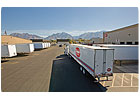
Wide Open Spaces
Standard Plumbing Supply’s massive trading area spans some of our country’s widest, most open spaces. It’s around 750 miles from Salt Lake City to the most distant branch in California. Getting goods from here to there and everywhere in between presents different challenges than those encountered by urban distributors.Covering this vast territory is made easier by a company-owned long-haul trucking subsidiary named Standard Logistics. Standard Plumbing Supply had established its own trucking operation long ago, motivated in large measure to achieve shipping economies associated with a couple of plastic pipe and nipple manufacturing subsidiaries then owned by the company. After the founder’s retirement in 1992, the manufacturing operations were spun off to other sons while Richard Reese took over the supply business. Standard then got out of the trucking business.
Common carriers proved to be an expensive and inefficient way to service its far-flung stores, however. So the company got back into trucking in the early part of this decade, and several years ago set it up as a separate corporate entity due to liability issues. Although trucking is a difficult and heavily regulated business to manage, it gives Standard control over its own branch shipments and enables the company to defray transportation expense by booking return hauls as a licensed common carrier. It also simplifies the handling of returns from the branches.
Standard’s fleet measures upwards of 120 trucks, managed by a sophisticated dispatching system. Branches are responsible for their own deliveries to customers and may also obtain merchandise from nearby branches in a pinch, but Standard’s main fleet, based at headquarters, hauls goods daily from the distribution center to the branches. The company performs its own vehicle maintenance out of a dedicated building at the headquarters complex.

Coping With The Downturn
Relying heavily on residential housing, Standard has seen its 15-year string of astounding growth hit a wall and back up a bit this year. They saw the downturn coming last year, however, and have employed various tactics to alleviate the hit.“Our business philosophy has changed a bit,” said Reese. “Rather than chase every job, we are a little less aggressive. There’s only so much business you can take with little margin and stay afloat. We think we’re entitled to make a fair return on providing service, which is hard to do when you’re bidding jobs against five supply houses.”
Staff has been reduced by about 50 people in the past year, mostly due to natural attrition. On the inventory side, the company has cut stock by about 15% in the past year, and Reese thinks they can squeeze out another 15% without seriously reducing customer service. “Even the best of branches collect materials that will not sell as anticipated,” he noted. Standard’s inventory reduction drive consists of identifying the slow movers more quickly and taking them out for redistribution to other branches that might need them. With 70 branches, there are plenty of potential buyers for oddball merchandise. It’s a matter of identifying who needs what when and getting it to them quickly. Standard’s computer software excels in connecting those dots.
As with many of our industry’s distributors, an ongoing effort is underway at Standard to revamp the sales force. “Outside salesmen are an important part of what we do, but their role is changing,” said Reese. “They have a different function than they did even three or four years ago. We have to address the high cost of sales, because our competition now includes Home Depot and Lowe’s, which don’t have the same costs.
“We’re trying to transition them into relationship managers, rather than outside salesmen who own a bunch of accounts,” he explained. “A relationship manager is someone available to the customer when that customer wants him. They must take care of all issues the customer might have, be they credit-related, delivery-related or whatever. They must make sure the customer is aware of everything we’re doing in terms of the Internet, job quotes, warranty issues and so on. This requires them to spend more time inside and less time driving around looking for the contractor who’s out on a job and can’t be found.”
Here To Stay - For Now
The Reese family traces its heritage back to the original Mormon migration to Utah in 1847. They adhere to the faith’s reverence for family and tradition, and Richard Reese has seven children, the oldest nearing college graduation. He believes that at least one of them will choose to keep the business running as an independent family enterprise well into the future. This intention comes with a caveat, however.“The biggest problem with wholesaling is it’s a capital-intensive business, and it’s extremely difficult to generate that capital. In other industries you open a location and it results in cash flow. Open a location in ours and you won’t see positive cash flow for years. We don’t sell for cash, but on account, so our profit ends up in slow-moving inventory and accounts receivable. As an industry we have way too much dead inventory, way too much bad credit, way too much underselling of the services we provide. Yet at the end of the year we have to pay the government in cash. The tax man won’t take our discontinued faucets or accounts receivable,” said Reese.
“Entrepreneurially, the independent distributor can be tough for the national chains to compete against. But the largest challenge facing the independent distributor is how to generate capital and turn profits into liquid items that can be invested in wise ways.”

[sidebar] Standard's Category-Killer Showrooms
There may be plumbing wholesalers that operate more showrooms than the 50 spanning Standard Plumbing Supply’s expansive territory, but not too many. There may be larger showrooms around than its 14,000-sq.-ft. pride and joy at company headquarters, but very few. And the ones that are that large almost invariably showcase an array of home furnishings that include cabinets, lighting, tile and so on. After some experiments with lighting and other home products, Standard Plumbing Supply has settled on a plumbing-only strategy for its showrooms.“Our approach is to be a category killer with our larger showrooms,” said President Richard Reese. “They display a large array of product and we have a large inventory, so if necessary we can get whatever a customer wants overnight.”
Reese said that around 70% of Standard’s volume derives from wholesale trade sales. Showrooms provide most of the rest of the volume, and an even larger percentage of the bottom line.
Showrooms fall under the authority of Dave Freeman, vice president of showrooms and showroom initiatives, assisted by Showroom Coordinator Diane Magario, who heads all showroom staffs. Virtually every plumbing branch includes a showroom. In smaller stores they will span around 2,000 sq. ft., while various “hub” showrooms in bigger towns will occupy around 7,000 sq. ft.
Showroom design and layout are standardized, both literally and figuratively, if one cares to play on the company’s name. Central staffers determine which products will go on display at every branch, and how they’ll be laid out. Wooden display mounts are fabricated to common specifications at company headquarters. These specs factor in not only the showroom arrangements, but also the fewest cuts and least waste, as well as ease of shipment to branches.
A product selection committee decides what to display. It is composed of four women, one each in their 20s, 30s, 40s and 50s, to reflect generational preferences. “Our showrooms are designed around women, because 95% of our customers are women,” said Freeman. Likewise, “most showroom attendants are women, because they communicate better with one another.”
Emphasis is on suites and vignettes, with the biggest ticket items likely to be the first thing viewed by showroom visitors. It’s part of a “sell up by selling down” sales psychology. TOTO and American Standard are Standard’s primary fixture lines, although they also showcase a large array of luxury fixture and faucet lines. In keeping with contemporary display trends, the vast majority of fixtures on display are white.
President Richard Reese views the company’s showrooms as a boon to contractors, although he concedes that “some don’t see it that way.” Nonetheless, they adhere to industry norms in selling above trade prices and giving rebates to contractors involved in the sale.

A separate company division, Showroom Services, exists for the main purpose of making sure showroom personnel are able to fulfill the order. Unlike the drive to eliminate inventory for the wholesale portion of the business, Showroom Services sits on some $5 million worth of inventory to make sure everything is available and ready when a project gets underway. This division also enables Standard to virtually guarantee next-day shipment of almost anything displayed in its showrooms.
If that sounds like a big inventory burden, keep in mind that it consists mostly of merchandise already sold and awaiting shipment. A construction or remodeling project might require products from 10 different vendors, all with different shipping schedules. Showroom Services accumulates the merchandise for complete shipment when a job begins.
This inventory is stored in a separate building at corporate headquarters. Showroom Services also serves as a surplus stock repository, and serves the company’s budding master distribution business.

[sidebar] Inventory Control Minus Inventory!
Throughout its history Standard Plumbing Supply has continually refined its central distribution practices to maximize efficiency and minimize dead stock. Its track record of success for more than a half-century owes in large measure to inventory control systems that have usually surpassed industry norms in sophistication.The current system takes it to a new level. Consider that this distributor feeds a network of 70 branches spread throughout almost a million square miles of wide open spaces from a single headquarters distribution center. The company averages around six turns, with a DC inventory value of merely $1.45 million, about half of which is Plumber Friendly private label imports. Another $300,000 of Stock Support inventory is sorted product waiting for the pallet to be completed and transferred. (The pallets accumulate for each branch until they are the desired height.) President Richard Reese thinks they can reduce DC inventory to around $1 million.
People who understand PHCP distribution may be thinking the numbers just reported are typos. How can they possibly sustain 70 far-flung branches with less than a million-and-a-half worth of inventory? It stems from what might be called a system of non-inventory control.
Vendor shipments get unloaded and immediately routed to the branches via a high-speed computerized conveyor and sorting system. Receiving and sorting is a single process handled by only a couple of employees. Material comes in, gets unpacked, then is sent through an electronic eye at the beginning of a long conveyor with 75 diverting lanes assigned to branches or departments. Products get routed to the branches based on orders placed for that branch by the central purchasing function.
Wait, it gets even better. The system may alter branch allocations based on real time data. Central purchasing might have ordered 10 items for a certain branch a week ago based on its EOQ, but in the meantime another branch may have turned up with greater need. The computer will shortchange the original branch and route the incoming products instead to the location with more critical need, or it may split the order between the branches.
The conveyor diverts to the correct branch lanes by timing. An operator keys in the products upon receipt, and then places them on the conveyor. At the beginning they pass by an electronic eye. That mechanism senses the time between that product/box/case and the next one in line, and the timing between each item on the conveyor determines the lane to which it will be diverted. Products not assigned to any branch will be placed in storage at the central warehouse. The system includes a fail-safe circle route. If the electronic eye fails to read the routing data correctly, the product will make a full lap of the conveyor without diverting. Then it gets shunted into a “mistake” chute for manual adjustment. It’s an electronic ballet unlike any this reporter has witnessed in hundreds of visits to PHCP supply houses.
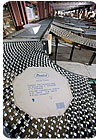
The sorting technology is fascinating, but the real marvel is the jury-rigging that brought about this system.
The first sorter was purchased on e-Bay in January 2005 and came from a closed clothing distribution center. It contained 26 sortation lanes that were designed to route product into 26 truck bay lanes. When it arrived in Utah, the company that had taken it down had done such a poor job that Standard’s engineer felt it was junk. They also had not shipped any of the controls that were part of the package. The engineer advised Reese to cut his losses and scrap the system. Unwilling to give up, Reese kept the sorter in the yard.
He found another sortation system with 49 lanes for sale in the classified section of a Sunday newspaper. They bought it and put it together to test it out in an existing building in July of 2005. In October of that year, they moved the sorter into a new distribution center building. The night they took the system down to move it, the company’s conveyor engineer, who had integrated the company computer system with the sorter computer system, died of a heart attack. They continued to move the system and started it up two weeks later, but were unable to make the system work in the new configuration. After some long days of IT brainstorming, they found the program imbedded in the system and were able to make the sorter work again. In February 2006, they added the 26-lane sorter into the loop with the 49-lane sorter, then purchased a pallet conveyor system from a business with a couple of closed warehouses and added it to the system.
The system contains a controller and one 20-ft. alignment conveyor that were purchased new. All the rest of the equipment came from the sources listed. The programming was all custom.
Despite all the turmoil and aggravation, the piecemealing and perseverance ended up producing a marvelous inventory management system for a total cost estimated at around $267,000, including engineering, installing, moving and programming. The engineers who worked on it informed Reese that to purchase such a system new would have entailed a price tag of around $3 million.
“I really didn’t know what we were getting into, and if I did know I probably wouldn’t have done it,” said Reese. “But it’s turned out to be the best thing we’ve ever done.
“We’ve been in the distribution business a long time, and have always faced the problem of how to distribute efficiently. We’ve tried everything - buying in bulk, direct shipments and so on - but none of it’s ever worked as well as we’ve wanted. It all involved a lot of shipping and pulling, and too many mistakes of buying the wrong stuff or not being able to find it on the shelves. This system here is the only way we’ve ever been able to control inventory to a level I feel is successful,” said Reese.
“We’ve made mistakes, but somehow we try to turn those lemons into lemonade,” he concluded.
[sidebar] SUPPLY HOUSE TIMES Wholesalers of the Year
1959 - Robertson Supply1960 - Noland Co.
1961 - EMCO Ltd.
1962 - Raub Supply
1963 - Atlas Supply Co.
1964 - A.Y. McDonald
1965 - Horne-Wilson
1966 - Taylor Cos.
1967 - Palmer Supply
1968 - J. Levitt
1969 - Kiefaber Co.
1970 - None
1971 - None
1972 - None
1973 - Hajoca
1974 - Ferguson Enterprises
1975 - Standard Plumbing Supply
1976 - CSC Inc.
1977 - Trumbull Supply
1978 - Harry Cooper Co.
1979 - F.W. Webb
1980 - Slakey Bros.
1981 - RAL Corp.
1982 - Familian NW
1983 - Moore Supply
1984 - Apex Supply
1985 - Noland Co.
1986 - Familian Corp.
1987 - Hughes Supply
1988 - Davis & Warshow
1989 - LaCrosse Plumbing Supply
1990 - A.Y. McDonald
1991 - RAL Corp.
1992 - Columbia Pipe & Supply
1993 - LCR Corp.
1994 - Ferguson Enterprises
1995 - Hughes Supply
1996 - Familian NW
1997 - F.W. Webb
1998 - Apex Supply
1999 - Torrington Supply
2000 - Wolff Bros.
2001 - Lehman Pipe & Supply
2002 - Todd Pipe & Supply
2003 - Davis & Warshow
2004 - WinWholesale
2005 - Castle Supply
2006 - Red Man Pipe & Supply Co.
2007 - Standard Plumbing Supply

Standard Snippets
Annual Product ShowMost state and regional trade associations in our industry would be thrilled to match the participation in Standard Plumbing Supply’s annual product show, held in March. More than 2,000 visitors turn out to view the displays of around 150 exhibitors and partake of food, drink and live entertainment. Standard buses in customers from all over its territory, and even flies some in from the most distant reaches. They reserved 250 hotel rooms for last year’s event, making the company a Chamber of Commerce favorite.
Dave Freeman, a former administrator with the Boy Scouts of America, conceived and manages the event. “Dave is a natural promoter,” said President Richard Reese. “An event like this is hard to pull off, but he has really figured it out.”
Practice What You Preach
The showrooms of Standard Plumbing Supply all have stylish public bathrooms equipped with top-notch fixtures, brass and trim. This is so basic you’d think all showroom operators would do it, but it’s not uncommon to encounter some that have the feel of service station restrooms.
Master Distribution
Like many other large PHCP distributors, Standard Plumbing Supply has begun to use its large purchasing power to serve as a master distributor for selected product lines, especially those tied to showroom sales. “We’ve only been in the redistribution business about a year and a half and are still feeling our way around,” said President Richard Reese. “There are some very viable master distributors out there with great customer relationships, so we will try to do something different.”
Internet selling is another way for a company with large inventory capabilities to leverage those assets. For the last several years Standard operated an Internet retail subsidiary, www.buyplumbing.net. Reese informed me, however, that as of this writing negotiations were underway to sell that business.
I.D. Copper Purchases
“We I.D. major copper purchases,” reads a warning decal at the entrance to all the Standard branches we visited. This was in response to some incidents of terminated employees of large customers stopping by to make large copper purchases on their former company accounts shortly after being dismissed. Not a single episode has occurred since the signs went up.
Packaged Hydronics
Standard Plumbing Supply does more than sell hydronic heating products. It puts together panels of packaged hydronics systems, as shown here, for radiant heating or snowmelt installations. This enables plumbing contractors as well as heating specialists to tap into this market.
Standard centralizes this function at company headquarters, since most of the little towns it serves are too small to justify a dedicated hydronics operation.
Repair Parts
A small section of Standard’s headquarters branch is devoted to something few wholesalers provide anymore - plumbing repair parts - via a unit called Standard Master Parts Supply. Most wholesalers shy away from the parts business because it’s full of dead inventory and penny-ante sales. Standard looks at it as one more reason for customers to pay them a visit, and when they do, they just might decide to buy a bunch of other stuff as well. Also, Standard’s 70 locations increase the chance that someone, somewhere will need the oddball pieces they stock.
